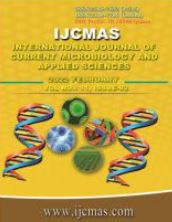


 National Academy of Agricultural Sciences (NAAS)
National Academy of Agricultural Sciences (NAAS)

|
PRINT ISSN : 2319-7692
Online ISSN : 2319-7706 Issues : 12 per year Publisher : Excellent Publishers Email : editorijcmas@gmail.com / submit@ijcmas.com Editor-in-chief: Dr.M.Prakash Index Copernicus ICV 2018: 95.39 NAAS RATING 2020: 5.38 |
The infection of sterile body fluids is potentially significant as growth of even one colony of a pathogenic microorganism can lead to life threatening consequences. Less number of pathogens and prior empirical antibiotic therapy in patients result in very fewer positive cultures. Hence the study was conducted to isolate the causative organisms of sterile body fluid infections and determine their antimicrobial susceptibility pattern. The body fluids received in the department of Microbiology KIMS Secunderabad were processed in BacT/ALERT 3D by inoculating them in FA Plus bottles under aseptic conditions for 5 days. 2190 samples studied out of which 1110 (50.68%) were cerebrospinal fluid, 498(22.73%) were pleural fluids, 456 (20.82%) were ascitic fluids, and 126(5.75%) were synovial fluid. The predominantly isolated bacteria were Klebsiella pneumoniae followed by Escherichia coli, Staphylococcus aureus, Enterococcus spp., Viridans streptococci, Pseudomonas aeruginosa, Streptococcus pyogenes, Acinetobacter spp., Serratia, Enterobacter cloacae, Streptococcus pneumonia and other Gram negative bacteria. Gram negative isolates were 100% sensitive to Colistin followed by Tigecycline (85%), Carbepenems (80%), Cefoperazone sulbactum (62%) and Cefepime (62%). Staphylococcus isolates were maximum sensitive to Vancomycin, Linezolid and Tigecycline. Among GNBs (enterobacterales) high resistance was observed to Ciprofloxacin(15.3%) and Amoxicillin clavulanic acid (30.7%). The current shift is an ever-increasing speed of antibiotic resistance in both gram negative and gram-positive isolates. It calls for a strict and organised surveillance and monitoring in hospitals, so the physicians can immediately acquire latest details on prevalence and antimicrobial susceptibility pattern which helps in shaping their clinical therapeutic judgement.
 |
 |
 |
 |
 |